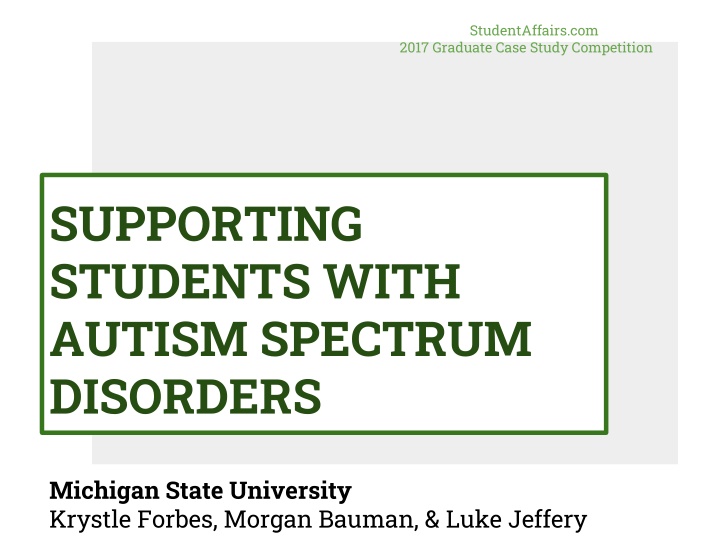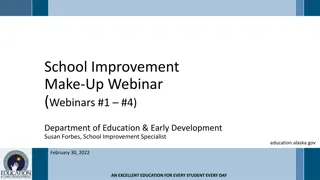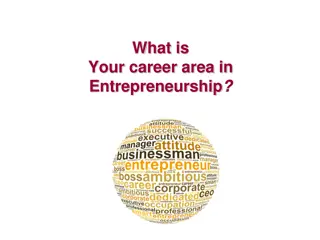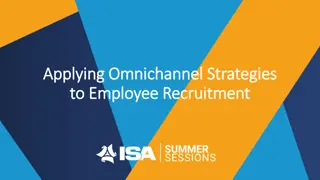
Supporting Students with Autism Spectrum Disorders - A Comprehensive Case Study
Explore a graduate case study competition by Michigan State University focusing on supporting students with Autism Spectrum Disorders (ASD). Learn about the context, definition of ASD, rising diagnoses nationwide, and challenges faced by underrepresented students in accessing proper healthcare and education.
Download Presentation

Please find below an Image/Link to download the presentation.
The content on the website is provided AS IS for your information and personal use only. It may not be sold, licensed, or shared on other websites without obtaining consent from the author. If you encounter any issues during the download, it is possible that the publisher has removed the file from their server.
You are allowed to download the files provided on this website for personal or commercial use, subject to the condition that they are used lawfully. All files are the property of their respective owners.
The content on the website is provided AS IS for your information and personal use only. It may not be sold, licensed, or shared on other websites without obtaining consent from the author.
E N D
Presentation Transcript
StudentAffairs.com 2017 Graduate Case Study Competition SUPPORTING STUDENTS WITH AUTISM SPECTRUM DISORDERS Michigan State University Krystle Forbes, Morgan Bauman, & Luke Jeffery
CONTEXT SETTING
WHAT IS AUTISM SPECTRUM What is Autism? Autism is now referred to as autism spectrum disorder (ASD), and encompasses previously defined separate yet similar disorders like Asperger syndrome. Autism spectrum disorder is a neurodevelopmental disorder involving deficits in language, communication, and social behaviors. Subscribe - https://goo.gl/w5aaaV. More videos - https://goo.gl/UhOKiM. Support us on Patreon - https://goo.gl/ZGHEk4. This video explores the previous and updated diagnostic criteria according to the diagnostic and statistical manual for mental disorders. Subscribe - http://www.youtube.com/channel/UCNI0qOojpkhsUtaQ4_2NUhQ?sub_confirmation=1 This video is brought to you by Osmosis. Along with providing open-access videos, Osmosis offers a comprehensive e-learning platform that connects med students with thousands of flashcards and quiz questions, depending on each student's needs. Ever wish information would just diffuse into your brain? Well, Osmosis helps make that possible don't learn it, osmose it! https://www.osmosis.org/ Support us on Patreon! - https://goo.gl/izRx2z We also have free practice questions for the USMLE and NCLEX-RN exams here: https://goo.gl/3oGOEi Also, we're social: Facebook - https://www.facebook.com/OsmoseIt/ Twitter - https://twitter.com/osmoseit Got feedback? We'd love to hear it! http://goo.gl/forms/T6de48NVzR This video is licensed under a Creative Commons CC-BY-SA 4.0 international license, which means that you're free to share and adapt it so long as you follow the Attribution and ShareAlike terms and conditions! Resources: https://en.wikipedia.org/wiki/Autism_spectrum http://www.nimh.nih.gov/health/topics/autism-spectrum-disorders-asd/index.shtml#part_145442 http://emedicine.medscape.com/article/912781-treatment http://www.ncbi.nlm.nih.gov/pmc/articles/PMC3005305/ http://www.uptodate.com/contents/autism-spectrum-disorder-terminology-epidemiology-and-pathogenesis?source=search_resultsearch=autism+spectrum+disorderselectedTitle=4~113#H12 http://www.dsm5.org/Documents/Autism%20Spectrum%20Disorder%20Fact%20Sheet.pdf https://www.autismspeaks.org/what-autism/diagnosis/dsm-5-diagnostic-criteria Credits: Script/audio/visuals: Tanner Marshall, MS Reviewer: Rishi Desai, MD, MPH Attributions: Funny boy laughing sound effect by Mike Koenig - http://soundbible.com/1825-Funny-Boy-Laugh.html Water drop sound sound effect by Mike Koenig - http://soundbible.com/1126-Water-Drop.html DISORDER (ADS)? Autism spectrum disorder (including Asperger syndrome) (Marshall, 2016)
WHY THIS IS IMPORTANT? Nationally, ASD diagnosis are exponentially on the rise. New Jersey (one of 11 participating states) has these highest prevalences of cases, nationwide (Roux et al, 2015) (U.S. Centers for Disease Control [CDC], 2016)
WHY THIS IS IMPORTANT ? Underrepresented students are diagnosed at a decreased rate, this is most likely due to other contributing factors such as socioeconomic status (access to healthcare) or parents education level (American Speech Language and Hearing Association [ASLHA], n.d; CDC,2016)
WHY THIS IS IMPORTANT ? People in the U.S. who continue education beyond high school can expect to earn more, be healthier, and live longer lives. 75% of youth in the general population attend some type of postsecondary education Only 36% of students with autism attend any type of postsecondary education Less than any other disability or learning disability or speech-language impairment (Roux et al, 2015, p.41) Beyond being good stewards of our mission and dedication to student support, limited research around support and success strategies for students with ASD provides opportunities (Gelbar, Smith, & Reichow, 2014) for our institution to be on the cutting edge of student development and support.
PROGRAM CONSIDERATIONS Shifting the conversation to a strengths based approach (Hart, Grigal & Weir, 2010), and focusing on what is unique about people with ASD s learning styles, improves student performance (Van Hees, Moyson & Roeyers, 2015) According to a 2015 study by Van Hees, V., Moyson, T. & Roeyers, H. J (2015) the challenge [to students with ASD transitioning to university] consisted precisely in the simultaneous combination of tasks and challenges in the three domains, resulting in major mental health issues. (p. 1677) While Van Heese, Moyson & Roeyers (2015) had a number of recommendations, we will be framing ours around the domains of personal achievement and academic success, in line with other university initiatives. Illustration from Van Hees, Moyson & Roeyers, 2015, p. 1677
RECOMMENDATION S Based on a review of the literature we recommend a three- pronged Disability Service program focusing on: PERSONAL INTEGRATION Challenge: Growing Self- Advocacy Skills SOCIAL INTEGRATION Challenge: Addressing Campus Culture ACADEMIC INTEGRATION Challenge: Breaking with the Familiar We have started the process of creating a committee consisting of: Director of Disability Services Representatives (1 each) from residence life, faculty & the office of student activities Mental health services administrator or counselor Committee s purpose: serve as a regular touchpoint for collaboration, resource planning and assessment data to ensure comprehensive, wrap-around support
PERSONAL INTEGRATIO N Challenge: Growing Self-Advocacy Skills Recognizing and Communicating Difficulties with planning, personal flexibility, and social communication, make it hard for students with ASD to recognize how and when to ask for help, often resulting in a failure to access adequate and timely support. Need (Rochester Institute of Technology, 2014) Accommodations In the k-12 system, most advocacy for services and support comes from the parent and students are not involved in planning and development conversations for their accommodations. (Hart et al., 2010; Rochester Institute of Technology, 2014) Receiving
PERSONAL INTEGRATIO N Mullendor and Banahan (2005) suggest orientation can be the defining moment in the transition to college for the student a time in which basic habits are formed that influence students academic success and personal growth and marks the beginning of a new educational experience (p. 319). (as cited in Grogan, 2015, pp. 9-10) Start the Process with Orientation Specialized Pre-orientation process where environment can be controlled for more optimal conditions Explain the process clearly and without inferences or idioms (Grandin & Panek, 2013) Allows time for students to familiarize themselves with campus (addressing the need for time to anticipate and process change) (Van Hees, Moyson & Roeyers, 2015) Begins the process of relationship development to create a supportive peer- network and sense of belonging on campus
PERSONAL INTEGRATIO N Utilizing Orientation Making systems of support Individual introductions and relationship building with key staff members and administration Making options clear and available (to allow processing time) Take-away resource to add to orientation materials Normalizing help-seeking behaviors (especially among peers) Rochester Institute of Technolog, 2014) Recognizing and Communicating Need Tiered system of responsibility release Ideally students will start to be involved in planning process in K-12 Involving parents in the initial planning phases provides an added level of comfort for student (Hart et al., 2010; Rochester Institute of Technology, 2014) Accommodations Receiving
SOCIAL INTEGRATIO N Challenge: Addressing Campus Culture Former understandings are based on ableist worldviews rooted in medical models. As such, students with ASD s potential is limited without contextual understandings of differences in mode of communication or environment needs. They are limited by what people think they can achieve. Identifying Constructs Social (Pe a, Stapleton, and Schaffer, 2016) Challenges with initiating conversations and the inability to read social cues leads to failed attempts to connect with peers and ultimately contributes to isolation and loneliness. Creating a Sense of Community Isolation and lack of a sense of belonging is a warning indicator for both retention and persistence, therefore of worthy consideration of administrators and faculty. (Rochester Institute of Technology, 2014, p. 5)
SOCIAL INTEGRATIO N Education, Reflection, & Community When considering an institutional response, practitioners should consider thinking outside the box on programming when working with and supporting students in all of their complexities (Pe a, Stapleton, & Schaffer, 2016, p. 93) Develop an awareness campaign on ASD Cultivate a deeper understanding of what ASD is within campus community Nurture a campus climate of inclusivity by highlighting the diverse student population Focus on strengths of students with ASD and shift away from deficit-based assumptions about students with ASD (Grandin & Panek, 2014) Create programming aimed at building community Establishing peer groups with others who hold similar identities allows students with ASD to feel a sense of belonging Future directions could include a peer mentoring program aimed at coaching students with ASD through social situations that may be difficult to navigate (Nevill & White, 2011)
SOCIAL INTEGRATIO N Engaging in Education, Reflection, & Community Collective community response informed by the awareness campaign aims to shift understanding in what valid knowledge looks like, challenging ideas of normalcy Identifying Social Constructs Henry et al. (2010) stated, institutions must move beyond legislation about accommodations for students with disabilities and start to embrace the spirit of the ADA (as cited in Pe a, Stapleton, & Schaffer, 2016, p. 93) Opportunities for students to interact in typical ways with peers provides a powerfully positive social experience for those students. When college students with ASD...talk about their experiences in college, they often mention that ... gives them a sense of esteem and belonging; less of a sense of other-ness than they had experienced previously. Creating a Sense of Community (Hart et al., 2010, p. 136)
ACADEMIC INTEGRATIO N Challenge: Breaking with the Familiar Applying New For students with ASD, K-12 success is often the result of rudimentary academic strategies. However, in college, students struggle to adapt learning methods to respond to various teaching styles and disciplines. Strategies (Rochester Institute of Technology, 2014) Interpreting the In post-secondary education, students with ASD may struggle due to the abstract nature and perspective- taking foundational to some disciplines and assignments. (Grandin & Panek, 2013; Rochester Institute of Technology, 2014) Abstract
ACADEMIC INTEGRATIO N Grandin and Panek (2013) noted if you really want to prepare [people] to participate in mainstream life, then you have to do more than accommodate their deficits. You have to figure out ways to exploit their strengths (p. 184). Operating under this deficit perspective, higher education often fails to recognize the great diversity in students with ASD and the success they can achieve in the college learning environment (Grogan, 2015). Universal Design for Learning (UDL) UDL acknowledges the diversity of strengths students with ASD bring to college. Move from passive learning via lecture to active learning via visual, auditory, and tactile methods (Grogan, 2015) Play to strengths by allowing students to choose assignments and break down barriers to traditional written assessment (Grogan, 2015) Recognizing faculty members are not experts in teaching, but in discipline, a concentrated effort to educate and train faculty and staff on the need for inclusive teaching and learning methods to engage both students with ASD and neurotypical students will be necessary.
ACADEMIC INTEGRATIO N Employing Universal Design for Learning Sufficient planning and clear communication Allow time to adapt to schedule, expectations, and changes Disclose teaching methods to students in advance Applying New Strategies (Van Hees, Moyson, & Roeyers, 2015) Varied assessment methods Allow students to demonstrate learning in ways that align with their strengths Use an array of techniques Play to students strengths as visual, auditory, or tactile learners to give a concrete method to abstract concepts Interpreting the Abstract (Grogan, 2015; Grandin & Panek, 2013)
BUDGET Item Cost Specialized Pre-Orientation Program Facilities usage & staff compensation Recommend applying for grants from Autism Speaks Family Services Similar programs funded by participant fees 1 Resources Awareness (printed materials) Utilize existing program promotion materials Awareness Campaign2 Total Proposed Costs $ 14,500 Marketing Materials (print) $2,000 Guest Speaker $5,000 Faculty and Administration Training3 Workshop Materials 3 $1,500 Guest Speaker $5,000 Peer Support Group Program Funding ($100 per facilitator) $1,000 1Rochester Institute of Technology, 2014 2Figures are approximate and determined based on similar awareness campaigns implemented at R1 institution serving approximately 40,000 students. 3This is an approximate cost based on 2 workshops with a projected attendance of 100 participants. The cost includes the assumed need for materials that may include flipchart paper, writing utensils, etc.
REFERENCES American Speech Language and Hearing Association (ASLHA). (n.d.) Autism. Retrieved from http://www.asha.org/PRPSpecificTopic.aspx?folderid=8589935303§ion=Incidence_and_Prevalence Gelbar, N. W., Smith, I., & Reichow, B. (2014). Systematic review of articles describing experience and supports of individuals with autism enrolled in college and university programs. Journal of Autism and Developmental Disorders, 44(10), 2593-2601. Retrieved from http://link.springer.com.proxy2.cl.msu.edu/article/10.1007%2Fs10803- 014-2135-5 Grandin, T., & Panek, R. (2013). The autistic brain: Helping different kinds of minds succeed. New York, NY: First Mariner Books Hart, D., Grigal, M., & Weir, C. (2010). Expanding the paradigm: Postsecondary education options for individuals with autism spectrum disorder and intellectual disabilities. Focus on Autism and Other Developmental Disabilities, 25(3), 134-150. Retrieved from http://journals.sagepub.com/doi/pdf/10.1177/1088357610373759 Marshall, T. (2016, March 21). Autism spectrum disorder (including Asperger syndrome) [video file]. Retrieved from https://www.youtube.com/watch?v=_HGUyk5U_j8 Nevill, R. E. A., & White, S. W. (2011). College students openness toward autism spectrum disorders: Improving peer acceptance. Journal of Autism Development Disorder, 41(12), 1619-1628. Pe a, E. V., Stapleton, L. D. and Schaffer, L. M. (2016), Critical Perspectives on Disability Identity. New Directions for Student Services, 2016: 85 96. Retrieved from http://onlinelibrary.wiley.com/doi/10.1002/ss.20177/pdf Rochester Institute of Technology. (2014). Emerging practices for supporting students on the autism spectrum in higher education: A guide for higher education professionals. Retrieved from https://www.rit.edu/~w- ssp/documents/ASDinHigherEdGuide.pdf Roux,A. M., Shattuck, P.T., Rast, J.E., Rava, J.A., & Anderson,K.A. (2015). National Autism Indicators Report: Transition into Young Adulthood. Philadelphia, PA: Life Course Outcomes Research Program, A.J. Drexel Autism Institute,Drexel University. Retrieved from http://drexel.edu/autisminstitute/research- projects/research/ResearchPrograminLifeCourseOutcomes/IndicatorsReport/#sthash.qCrXdtjd.dpbs The United States Centers for Disease Control and Prevention. (2016). Community report from the autism and developmental disabilities monitoring (ADDM) network: A snapshot of autism spectrum disorder among 8-year-old children in multiple communities across the united states in 2012. Retrieved from https://www.cdc.gov/ncbddd/autism/documents/community_report_autism.pdf Van Hees, V., Moyson, T., & Roeyers, H. (2015). Higher education experiences of students with autism spectrum disorder: Challenges, benefits and support needs. Journal of Autism and Developmental Disorders, 45(6), 1673-1688. Retrieved from http://link.springer.com/article/10.1007/s10803-014-2324-2




















